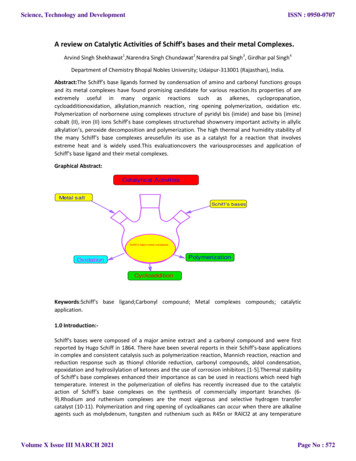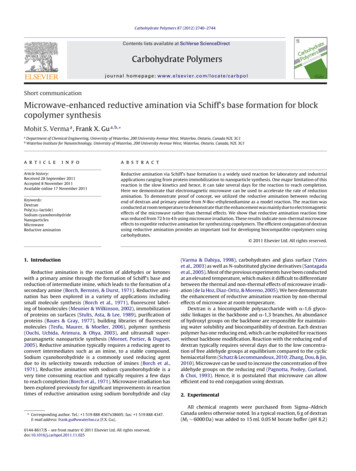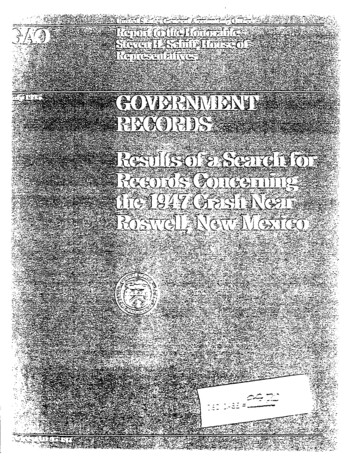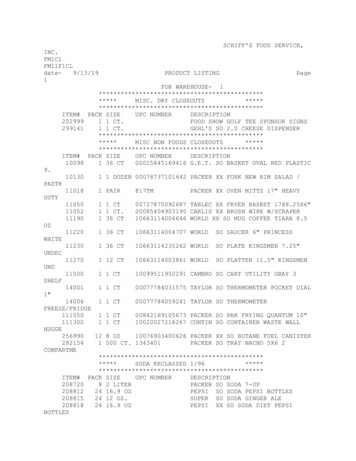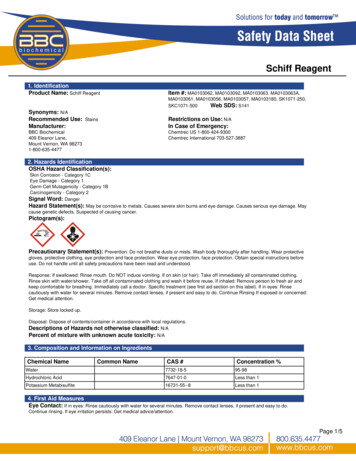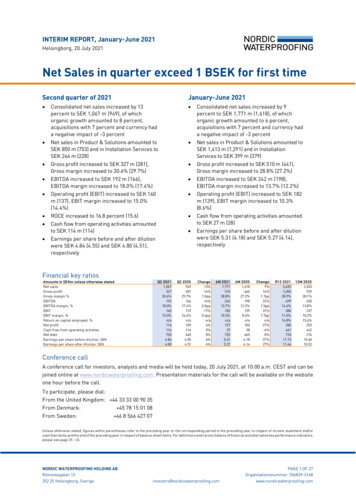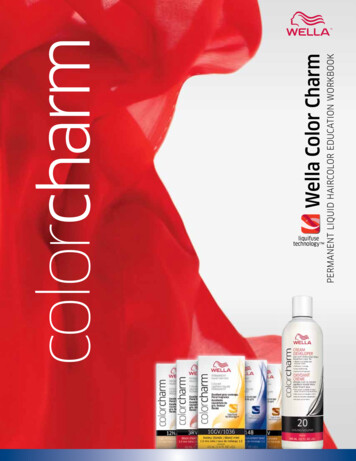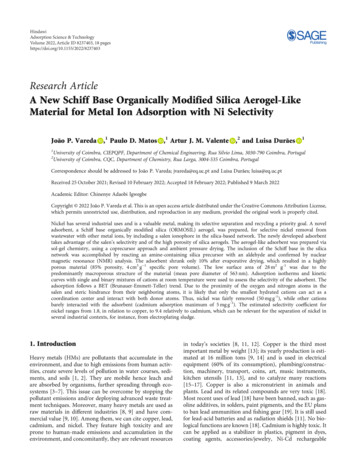
Transcription
HindawiAdsorption Science & TechnologyVolume 2022, Article ID 8237403, 18 pageshttps://doi.org/10.1155/2022/8237403Research ArticleA New Schiff Base Organically Modified Silica Aerogel-LikeMaterial for Metal Ion Adsorption with Ni SelectivityJoão P. Vareda ,1 Paulo D. Matos ,1 Artur J. M. Valente ,2 and Luisa Durães121University of Coimbra, CIEPQPF, Department of Chemical Engineering, Rua Sílvio Lima, 3030-790 Coimbra, PortugalUniversity of Coimbra, CQC, Department of Chemistry, Rua Larga, 3004-535 Coimbra, PortugalCorrespondence should be addressed to João P. Vareda; jvareda@eq.uc.pt and Luisa Durães; luisa@eq.uc.ptReceived 25 October 2021; Revised 10 February 2022; Accepted 18 February 2022; Published 9 March 2022Academic Editor: Chinenye Adaobi IgwegbeCopyright 2022 João P. Vareda et al. This is an open access article distributed under the Creative Commons Attribution License,which permits unrestricted use, distribution, and reproduction in any medium, provided the original work is properly cited.Nickel has several industrial uses and is a valuable metal, making its selective separation and recycling a priority goal. A noveladsorbent, a Schiff base organically modified silica (ORMOSIL) aerogel, was prepared, for selective nickel removal fromwastewater with other metal ions, by including a salen ionophore in the silica-based network. The newly developed adsorbenttakes advantage of the salen’s selectivity and of the high porosity of silica aerogels. The aerogel-like adsorbent was prepared viasol-gel chemistry, using a coprecursor approach and ambient pressure drying. The inclusion of the Schiff base in the silicanetwork was accomplished by reacting an amine-containing silica precursor with an aldehyde and confirmed by nuclearmagnetic resonance (NMR) analysis. The adsorbent shrunk only 10% after evaporative drying, which resulted in a highlyporous material (85% porosity, 4 cm3 g 1 specific pore volume). The low surface area of 28 m2 g-1 was due to thepredominantly macroporous structure of the material (mean pore diameter of 563 nm). Adsorption isotherms and kineticcurves with single and binary mixtures of cations at room temperature were used to assess the selectivity of the adsorbent. Theadsorption follows a BET (Brunauer-Emmett-Teller) trend. Due to the proximity of the oxygen and nitrogen atoms in thesalen and steric hindrance from their neighboring atoms, it is likely that only the smallest hydrated cations can act as acoordination center and interact with both donor atoms. Thus, nickel was fairly removed (50 mg g-1), while other cationsbarely interacted with the adsorbent (cadmium adsorption maximum of 5 mg g-1). The estimated selectivity coefficient fornickel ranges from 1.8, in relation to copper, to 9.4 relatively to cadmium, which can be relevant for the separation of nickel inseveral industrial contexts, for instance, from electroplating sludge.1. IntroductionHeavy metals (HMs) are pollutants that accumulate in theenvironment, and due to high emissions from human activities, create severe levels of pollution in water courses, sediments, and soils [1, 2]. They are mobile hence leach andare absorbed by organisms, further spreading through ecosystems [3–7]. This issue can be overcome by stopping thepollutant emissions and/or deploying advanced waste treatment techniques. Moreover, many heavy metals are used asraw materials in different industries [8, 9] and have commercial value [9, 10]. Among them, we can cite copper, lead,cadmium, and nickel. They feature high toxicity and areprone to human-made emissions and accumulation in theenvironment, and concomitantly, they are relevant resourcesin today’s societies [8, 11, 12]. Copper is the third mostimportant metal by weight [13]; its yearly production is estimated at 16 million tons [9, 14] and is used in electricalequipment (60% of its consumption), plumbing/construction, machinery, transport, coins, art, music instruments,kitchen utensils [11, 13], and to catalyze many reactions[15–17]. Copper is also a micronutrient in animals andplants. Lead and its related compounds are very toxic [18].Most recent uses of lead [18] have been banned, such as gasoline additives, in solders, paint pigments, and the EU plansto ban lead ammunition and fishing gear [19]. It is still usedfor lead-acid batteries and as radiation shields [11]. No biological functions are known [18]. Cadmium is highly toxic. Itcan be applied as a stabilizer in plastics, pigment in dyes,coating agents, accessories/jewelry, Ni-Cd rechargeable
2batteries, and solar cells [20, 21], with the latter two contributing to impulse its use [21]. The EU has banned it frombeing used in plastics, paints, and jewelry [22]. In this paper,we focus our particular interest in nickel due to its increasingmarket value. Nickel is ferromagnetic at room temperature[11] and is known to catalyze reactions [23]. It is used forthe production of metal alloys (stainless steel totals 75% ofits consumption [24]), nickel cast iron (jewelry, coins),corrosion-resistant coatings by electroplating, and the production of batteries (nickel-metal hydride and Li-ion) [11,25, 26]. Nickel has biological functions in plants and cyanobacteria [26]. Due to the aforementioned reasons, nickel is avaluable metal, so the minimization of its pollutant discharges, through separation and recovery, has economicimpact on businesses. Furthermore, these also contribute toa more circular and sustainable economy, which manycountries are promoting.Several treatment techniques can be applied to removeheavy metals from wastewaters. These were fully describedin a recent review of the authors [1]. However, only a fewcan be used for the simultaneous goal of recovering the cation being removed from water: ion exchange [27–29],adsorption [30–36], and electroplating [27, 28, 37] are themost effective ones. As such, operating these methods withhigh efficiency and low-cost at large scale is crucial to promote the recovery of metals as valuable resources. Bothadsorption processes rely on the development of high performing materials (the ion exchanger and adsorbent, respectively) that are modified to be selective, while electrolysis canbe employed for multiple species by assembling an electrolytic cell and adjusting electric potential on demand. However, a major drawback relies on the fact thatelectrochemical processes are expensive and only viable incases where wastewater are not highly contaminated. Onthe other hand, adsorption processes are simple in operationand design, and their cost is mostly associated with the sorbent materials [27, 28, 37]. Natural materials as well as engineered ones have been used as adsorbents for heavy metals,and the number of published research on the topic has beenincreasing [1].Schiff bases are the most common family of moleculesused as nickel ionophores [38]. They are considered a subclass of imines and are obtained by a condensation reactionof a primary amine and a carbonyl precursor, e.g., an aldehyde [39]. These molecules can be multidentate and are generally based on nitrogen or oxygen donors but can alsoinclude phosphor and sulfur [39]. The formation of theligand-nickel (II) complex was studied with different Schiffbases by several authors developing colorimetric nickel sensors (in which the response to the cation is measured byabsorbance in the ultraviolet-visible region or by fluorescence), and it was found that the stability constant is veryhigh (log K 5) [40–44]. Ganjali et al. [43] confirmed theligand’s selectivity by evaluating the stability constanttowards copper (log K 5:9 for Ni (II) vs. 4.2 for Cu (II)).A particular case of Schiff base, salens (symmetrical tetradentate molecules with two nitrogen and two oxygendonor atoms [39]) were studied by Gupta and coauthors[44, 45]. They have successfully used salens as ionophoresAdsorption Science & Technologyin ion sensing electrodes with poly(vinyl chloride) membranes [44, 45]. In one of the works, the authors have proposed two distinct molecules as nickel ionophores(Figure 1), both with very high affinity for nickel (log K 7for Ni (II) and 4.2 for the remaining cations) [44]. In theliterature, the use of salens can also be found for the modification of MCM (Mobil Composition of Matter) and SBA(Santa Barbara Amorphous) particles [46–52], silica gel[53], or silica composites [54], in order to promote salenmetal cation complexes. However, only three works usingsilica-based materials, by Enache et al. [52], Kursunlu et al.[53], and Qiao et al. [54], are reporting adsorption studies.It should be mentioned that salens are also reported as copper ionophores [55, 56], responding selectively to this cationand exhibiting very high stability constants (log K 4:2 [55]or 8.4 [56]). So, the selectivity of the Schiff base ligand mustbe influenced by the nonelectron donor groups in the molecule that affect, for instance, its overall size and accessibilityof ions to the electron donor groups.In this work, we report the development of a selectiveadsorbent for nickel, obtained by modifying the silica matrixof a silica aerogel with hemi-salen functional groups. Thus, ahighly porous and selective adsorbent is obtained. To thebest of our knowledge, it is the first time a silica aerogel ismodified using such a functional group. The modifiedaerogel-like monolith is tested in batch tests to assess its suitability and selectivity against common relevant cations.2. Materials and Methods2.1. Materials. As silica sources, methyltriethoxysilane(MTES, 99%), tetraethyl orthosilicate (TEOS, 98%), and(3-aminopropyl) trimethoxysilane (APTMS, 97%) werepurchased from Sigma-Aldrich and used as received. Salicylaldehyde (p.a., Merck) was used to obtain the hemi-salenmodifying groups on the silica matrix. Anhydrous oxalicacid ( 99%, Sigma-Aldrich) and ammonium hydroxide(25% NH3 in H2O, Sigma-Aldrich) were the sol-gel chemistry catalysts. Methanol (MeOH, 99.8%, VWR) and ethanol(EtOH, 99.8%, Fisher) were used as solvents. Deuteratedmethanol (CD3OD, 99.8%, Eurisotop) and 3-(trimethylsilyl)propionic acid sodium salt (TMSP, 98%, Eurisotop) wereused as solvent and internal reference for NMR spectroscopy. Heavy metal solutions were prepared using copper(II) nitrate hemipentahydrate (p.a., Chem-Lab), lead (II)nitrate ( 99.0%, Sigma-Aldrich), cadmium (II) nitrate tetrahydrate ( 99.0%, Sigma-Aldrich), and nickel (II) nitratehexahydrate (crystals, Sigma-Aldrich). High purity waterwas used whenever needed. Nitric acid (65%, Fisher) wasused to adjust the pH of solutions.2.2. Modification of APTMS Co-precursor. The addition of aSchiff base functional group to the silica matrix was achievedby modifying the organic group in a silicon alkoxide precursor. The reaction between the primary amine of APTMS andsalicylaldehyde was promoted [46, 47], resulting in a hemisalen modified silica precursor (HSPTMS, enol), as shown inFigure 2.
Adsorption Science & Technology3NHHNNNOH lidene))bis(naphthalen-1-ol)Figure 1: Representation of the ionophore molecules developed by Gupta et al. [44]. Proposed groups responsible for cation sorption arepresented in blue.OH3CH3CHOONH2 SiOOOHH3CCH3H3COHOSiCH3N H2OOFigure 2: Schematic representation of the HSPTMS formation reaction. Proposed groups responsible for cation adsorption are presented inblue, and the groups that take part in the reaction are shown in green.APTMS and salicylaldehyde were mixed in methanolwith a 10 mol% excess of salicylaldehyde. This mixture,labelled as A, was stirred until homogenization and left toreact in an oven for 24 hours at 27 C. The mixture turnedyellow instantly, indicating the formation of the hemi-salen.2.3. Synthesis of Schiff Base-Modified ORMOSIL Aerogel-LikeMonolith. To prepare silica aerogels with the HSPTMS precursor, MTES was diluted in methanol and hydrolyzed(0.1 M oxalic acid). After one day, the hydrolyzed MTES,mixture B, was mixed with the so-called mixture A and stirred. After a couple of minutes, TEOS and then the basic catalyst (1 M ammonium hydroxide) were added. All sol-gelsteps were carried out at 27 C. The Si: solvent: water molarratios in the sol were kept at 1 : 12 : 8, and the silica coprecursors were mixed in an 50/35/15 molar percentage forMTES, TEOS, and HSPTMS, respectively. Gelation andaging occurred in an oven at 27 C for six days. Aged gelswere demolded and washed by being immersed in hot ethanol for a total of six days, with ethanol being changed everyday. Finally, the gel monoliths were dried in an oven forthree days at 60 C.2.4. Characterization. The formation of HSPTMS was investigated via NMR (Bruker Biospin GmbH, 1H spectra collected at 400 MHz and 13C spectra collected at 100 MHz).1H and 13C spectra for both reactants and HSPTMS wereobtained by dissolution in deuterated methanol. The analysisof the 13C spectrum did not contribute with additional information relatively to the 1H spectrum analysis, and thus, it isnot shown. HSPTMS was obtained directly from mixture Avia evaporation of the solvent.The characterization routines of aerogels are describedin previous works by the authors [57, 58]. Bulk and skeletaldensities were used to obtain adsorbent porosity. Bulk density of the adsorbents was obtained by weighting the samplesand measuring their dimensions on the three axes. Skeletaldensity was obtained with ground samples by He pycnometry (Accupyc 1330, Micrometrics). Linear shrinkage was calculated from the change in diameter of the dried samplecomparatively to the gelation mold. The BET specific surfacearea was obtained through nitrogen adsorption (ASAP 2000,Micrometrics). Pore volume and average pore size were calculated in accordance with a previous work [59]. Microstructure observation was performed with field-emissionscanning electron microscopy (FE-SEM) (Merlin Compact/VPCompact FESEM, Carl Zeiss Microscopy GmbH) [60,61]. Fourier transform infrared spectroscopy (FTIR) (FT/IR 4200, Jasco) was performed, being the spectra obtainedwith KBr pellets in the wavenumber range of 4000 to400 cm 1, with 128 scans and a resolution of 4 cm 1. C, H,
4Adsorption Science & TechnologygH3COO SiOH3CH3CifbN ahdceHOaH3COO SiH3CObehf giaCH3dcbNH2bacdOaHdcb c deOHa10bc98de76541H Chemical shift (ppm)3210Figure 3: 1H NMR spectra for salicylaldehyde, APTMS, and HSPTMS.100 nm(a)(b)Figure 4: Photograph (a) and micrograph at 30 k magnification (b) of the Schiff base-modified aerogel.Table 1: Physical/structural properties of the functional aerogel-like monolith adsorbent.Bulk density (g cm 3)0:22 0:04Skeletal density (g cm 3)Porosity (%)Linear shrinkage (%)SBET (m2 g 1)V pore (cm3 g 1)Dpore (nm)1:396 0:00485 310 327:7 0:33:9 0:8563 122
5Transmittance (a.u.)Adsorption Science & Technology400035003000200015001000500Wavenumber (cm–1)Figure 5: Infrared spectrum of the adsorbent.Table 2: C, H, and N contents of the Schiff base-modified aerogellike monolith.Sample/hypothesisComplete condensationIncomplete condensation 1OHIncomplete condensation 2OHExperimental valueswt% Cwt% Hwt% N27.025.122.924:4 2:03.74.55.13:6 0:12.42.22.02:5 0:1and N content of powdered samples was determined by elemental analysis (EA 1108 CHNS-O, Fisons). Zeta potentialmeasurements of an aqueous suspension of the samplenanoparticles (0.1%, w/v) at pH 4 were carried out by electrophoretic light scattering (Zetasizer NanoZS ZN 3500,Malvern Instruments); the suspension was dispersed in anultrasound bath for 10 minutes, and the pH was adjustedby the addition of HCl just before measurements. The elemental composition of loaded adsorbent samples was estimated with energy-dispersive X-ray spectroscopy, EDS (XMaxN Silicon Drift EDS Detector, Oxford Instruments).Heavy metal concentration in solutions was determinedby flame atomic absorption spectroscopy (AAS) with anacetylene-air flame (939 AAS, Unicam).To provide insight on the interactions with the differentions, the geometry of hydrolyzed HSPTMS in water wascomputed. The system was composed of a box, with the precursor molecule surrounded by 632 water molecules, ofdimensions 2:6520 nm 3:1410 nm 2:4120 nm, and withfull periodic boundary conditions. The simulation was conducted in CP2K v7.1 [62] using the Geometry, Frequency,Noncovalent, eXtended Tight Binding (GFN-xTB) with theDFT-D3 dispersion correction [63, 64] as electronic model.2.5. Adsorption Tests. Adsorption experiments followed theprocedures used previously [57, 58, 65]. The aerogel-likemonolith was prepared for adsorption by milling and selecting particles within a size range of 75 to 250 μm. Batchadsorption tests were conducted by mixing the powderedadsorbent and the cation solution in a test flask, shaken ina rotational stirrer at speed setting 16 rpm (REAX 20, Heidolph Instruments) with an adsorbent dose of 2 g L 1 atpH 4 and 25 C. When the test ended, the solution was filtered, and the concentration of the filtrate was determined.For comparison, a silica aerogel without the Schiff base modification was tested in the same conditions.Isotherm studies were performed by varying the adsorbate concentration from 20 to 500 mg L 1 and conductedfor 24 h. The selectivity of the Schiff base ORMOSILaerogel-like monolith was studied in batch kinetic tests, withcontact times ranging from 5 minutes to 24 h, with an adsorbate concentration of 100 mg L 1 per cation. Binary mixturescontaining copper and mixtures containing nickel plus copper and nickel ions isolated were tested.The viability of recovering the adsorbed nickel wasassessed by a desorption test performed with HCl andHNO3 on nickel loaded particles (from the isotherm studieswith a starting concentration of 100 mg L 1). The loadedadsorbent was shaken with a 1 M solution of the desorptionagent for three hours.A minimum of two replicates were obtained for allreported data points.2.6. Analysis of Adsorption Data. All physical quantities andadsorption model parameters here described are definedwith mass units. While discussing binary mixtures, theseare expressed in molar units when required. Adsorptioncapacity (qt or qe if equilibrium is reached, mg g 1) was calculated from the initial (C0 , mg L 1) and final concentrations (C t or Ce , mg·L 1, respectively), adsorbent mass (m,g), and solution volume (V, L) according to Equation (1).Time t is expressed in hours. Selectivity was calculated withEquation (2) using the molar adsorption capacity after 24hours.q α1,2 V ðC 0 C Þ,mð1Þq1:q2ð2ÞFreundlich, BET, and Langmuir-Henry models werefitted to the equilibrium data to interpret the metal ionadsorbent interactions. The pseudo-first order and pseudosecond order models, as well as a modified pseudo-secondorder model that considers an initial adsorption, were testedto describe the kinetic data. The fits were performed usingnonlinear algorithms, and their quality was assessed usingAkaike and Bayesian information criteria [66].The Freundlich model [67], Equation (3), describes theadsorption on heterogeneous surfaces [68]. It has twoparameters: the Freundlich constant, K F ((mg g 1)(L mg 1)1/nF), that gives the relative adsorption capacity ofthe adsorbent, and the heterogeneity factor 1/nF. The BETmodel [69] describes multilayer adsorption and was
6Adsorption Science & Technologyqe (mg.g–1)45301500100200300400500Ce (mg.L–1)NiCdCuPbFigure 6: Adsorption isotherms in single-metal solutions.Table 3: Fit parameters for the isotherm models and maximum uptake by Schiff base-modified aerogel-like monolith.NiCdCuPb49.95.114.423.419 24 27:6 0:414 1K L 10 3 (L mg )7 24 387 24524 268K S 10 3 (L mg 1)1:6 0:01:2 0:30:99 0:080:8 0:2AICBIC18 322 195 830101/n F1:3 0:1qe,max exp (mg g-1)BET modelqm (mg g 1) 1 2 1ð2 1Þ 10K L (L mg )AICBIC2113qm (mg g 1)(a) 1Freundlich model1:1 0:10:33 0:04 30:16 0:041:7 0:48 2 67 181Langmuir-Henry model(a)6:6 0:923015ð9 4Þ 1014 2(a)(a)0:12 0:070:5 0:3K H 10 3 (L g 1)(a)(a)15 317 6AICBIC(a)(a)(a)(a)11 23212K F (mg g(a)-1 1/n(L mg )F)The model did not fit to the data.conceptualized for the adsorption of gaseous species. It canbe expressed for liquids with Equation (4) [70], in whichqm represents the monolayer adsorption capacity (mg g 1),K L is the equilibrium constant for the first adsorbate layer(L mg 1), and K S is the equilibrium constant for the upperlayers. C BET is equal to K L divided by K S . The LangmuirHenry model, Equation (5), combines both the Langmuirand Henry isotherms [71], describing adsorption both atactive surface sites and by the dissolution of the sorbateinside the porous matrix. K L is the Langmuir constant andhas the same meaning as in the BET isotherm (L mg 1),and K H is the Henry constant (L g 1).qe K F Ce 1/nF ,ð3Þ
Adsorption Science & Technology7The intraparticle diffusion and Boyd models were further applied to have a deeper analysis of the adsorption ofnickel on the aerogels (a similar analysis was not possiblefor copper due to its fast adsorption). The intraparticle diffusion model (presented by Weber and Morris) is based onFick’s 2nd law equation [74, 75] and can be describedthrough Equation (8)qt A0,i kP,i t 0:5 ,qeð8Þwhere A0 is a constant related with the thickness of theboundary layer, kP (s 0.5) is the rate constant and dependson the diffusion coefficient, and i is related with the numberof steps governing the adsorption process. On the otherhand, the Boyd model (also based on Fick’s 2nd law equation) was also shown to predict the rate limiting stepthrough the computation of the intercept of a linear equation described as Bt mt y0 , where Bt is defined by Equation (9) for short adsorption times.Bt 2π 1ÅFigure 7: Representation of the optimized structure of thehydrolyzed HSPTMS coprecursor. Fπ2πF 1/2 1 ð0 F 0:85Þ,33F qt:qeð9Þð10Þqe qm K L Ce,ð 1 K S C e Þ ð1 K S C e K L C e Þð4ÞIf y0 0, the rate limiting step is intraparticle diffusion;otherwise, film diffusion model governs the process [76, 77].qe qm K L C e K H Ce :1 K L Ceð5Þ3. Results and DiscussionIn the kinetic models used, the equilibrium uptake oradsorption capacity, qe , is a model parameter. In thepseudo-first order model [72], Equation (6), k1 is the firstorder rate constant (h-1). This model reveals that the adsorption is controlled by diffusion. A modified pseudo-secondorder equation, considering an initial adsorption, revealsan adsorption process controlled by the surface reactionand is described in Equation (7). In this model, q0 (mg g 1)represents the initial uptake, and the pseudo-second orderadsorption rate constant corresponds to k2 (g mg 1 h 1). Ifthe initial uptake is negligible, the equation is reduced tothe pseudo-second order model [73]. It was verified thatmodified silica-based aerogels adsorb heavy metals veryquickly [58]; hence, an initial uptake of sorbate can be considered in some cases. This can be attributed to the metalamount adsorbed during the preparation of the tests (whichis sometimes observed by changes in the aerogel color),before the flasks are shaken, which is considered the effectivestart of the test. The modified pseudo-second order modelcan describe these situations. qt qe 1 e k1 t ,qt q 0 q2e k 2 t,qe k2 t 1ð6Þð7Þ3.1. Schiff Base Reaction. The formation of HSPTMS, via thereaction illustrated in Figure 2, was studied, and the NMRspectra are presented in Figure 3. The formation of HSPTMScan be observed, namely, by the disappearance of the carbonyl group from salicylaldehyde (peak a, δ 10 ppm) andthe amine group in APTMS (peak b, δ 2.7 ppm) in theproduct, and the appearance of a new proton associated withthe C N bond (peak a, δ 8.4 ppm). Protons associated withthe methoxy groups and propyl chain did not suffer changesin their chemical environment, while the ones associatedwith the aromatic ring (peaks b-e in the salicylaldehydeand HSPTMS spectra) suffered some alterations, due to anew chemical environment.3.2. Modified Aerogel-Like Monolith Characterization. Theobtained modified silica aerogel-like monolith and itsporous morphology are depicted in Figure 4. The physical/structural properties of the adsorbent are summarized inTable 1.The ORMOSIL aerogel-like monolith samples feature adistinctive bright yellow color, due to the presence of thehemi-salen. Despite being dried by evaporation of the solvent, the gel remained a monolith and exhibits a small radialshrinkage, resulting in a bulk density and porosity similar tothat of amine modified silica aerogels and contrasting totheir xerogel counterparts [58]. The skeletal density of thisadsorbent is lower than that of silica, as it is observed with
8Adsorption Science & TechnologyTable 4: Fitting parameters of the kinetic models for the total adsorption in binary mixtures.Modified pseudo-second order modelq0 102 (mmol g 1) qe 10 (mmol g 1) k2 (g mmol 1 h 1)BIC0:8 0:3 10 512:5 0:39 1Ni Cu(a)3:7 0:3142 68 59 633:6 0:123 7 55 59Ni Pb7 22:8 0:30:4 0:2 9 502:6 0:20:3 0:1 38 46Cu Cd(a)1:7 0:432 29 27 391:6 0:28 6 24 37Cu Pb(a)1:3 0:251 32 551:3 0:14 1 46 54 470:9 0:4BICNi Cd(a)2:3 0:2Pseudo-first order modelqe 10 (mmol g 1) k1 (h 1) AICAIC 32 40Negligible value.ORMOSIL aerogels. As expected, the modification of the silica matrix with the Lewis base group impacted the structuralproperties of the adsorbent, as this sample is less porous(and hence, denser) than other ORMOSIL aerogels (withoutLewis base groups) or native silica aerogels [58, 59, 78, 79].For the Schiff base-modified aerogel-like monolith, hydrogen bonding with solvent molecules does not counter theeffect of nonhydrolysable apolar groups in the network,resulting in low capillary stresses during solvent evaporationand low shrinkages in the final material. This result can bedue to: the presence of the azomethine group (imine) insteadof a primary or secondary amine in amine modified gels;and/or the high pore radius. Thiol modified silica xerogelsalso retained monolithity after evaporative drying, and theirproperties are similar to the aerogel counterparts [57, 80].The specific surface area of this adsorbent is small, evenwhen compared to other ORMOSIL aerogels, and is due tothe predominant macroporous nature of the material, asindicated by the average pore size in Table 1. Previous worksshow that, in some situations, the specific surface area doesnot make a significant impact in adsorption performance[58, 80].The FE-SEM image depicted in Figure 4(b) confirms thehigh porosity of the sample, revealing numerous voids with awide distribution of pore sizes. In fact, many pores smallerthan the average pore size estimated (563 nm, Table 1) areobservable in this image. The pearl necklace type of microstructure expected from silica aerogels is visible. Additionally, the secondary silica particles are very small and seemto be poorly individualized, surely due to the extended agingperiod. This microstructure is similar to that of amine modified aerogels recently reported by the authors [58]. The evaluated structural properties allow to conclude that theprepared sample can be considered an aerogel, accordingto the different proposals for this definition [79, 81–83].The FTIR spectra and the C, H, and N compositions ofthe aerogel-like monolith are presented in Figure 5 andTable 2, respectively. The interpretation of the experimentalresults obtained by elemental analysis relies on theoreticalassumptions regarding the condensation of hydrolyzed precursor molecules in the sol, previously detailed by theauthors [65].The FTIR spectrum of the adsorbent reveals the formation of the silica matrix and the incorporation of the Schiffbase in its structure. Bands associated with siloxane bondsare visible at 577, 1099, and 1162sh cm 1; bands associatedwith the ortho substituted benzene ring are visible at 1464and 3100 cm 1, and the bonded hydroxyl groups generate abroad band at 3431 cm 1. Some bands are resultant fromthe overlap of different functional groups that vibrate at similar frequencies. The bands at 465 and 791 cm 1 are theresult of overlapping vibrations from siloxane bonds andthe benzene ring, while the band at 1632 cm 1 results fromthe overlapping of multiple bond stretching of the benzenegroup, the azomethine bond, and the hydroxyl groups.These bonds limit the conclusions gained from this analysis.The remaining bands are due to the methyl and methylenegroups in the MTMS and HSPTMS precursors.Analyzing the carbon content of the sample, the elemental analysis reveals that hydrolysis is not complete, suggesting an incomplete condensation of one hydroxyl group perSi. This result can be justified by the fact that HSPTMS coprecursor may undergo incomplete hydrolysis, in comparison to the remaining co-precursors, due to its slower reactivity and to it being added just before the base. Furthermore,the large organic group in this co-precursor is likely to hinder the formation of siloxane bridges. The nitrogen contentin the sample is superior to the predicted, which can berelated with the presence of ammonia residues even afterthe washing stage, as found before in samples withoutnitrogen-containing precursors [58]. The experimental valueobtained indicates that there are 1.8 mmol of hemi-salengroups per gram of adsorbent or 3:9 1019 active sites persquare meter. It was verified experimentally by EDS thatthe distribution of the coprecursors in the aerogel-likemonolith matrix is not homogenous, as expected. Nitrogenwas not detected with statistical significance in some portions of sample, and in others reached 4 wt%. The hydrogencontent is inferior to the predicted, but this element is alsomore affected by the randomness of the network ramification. The excess of salicylaldehyde seems to be completelyremoved by the washing stage, as the carbon content wouldexceed the predictions if otherwise.The addiction of the hemi-salen groups caus
Oct 25, 2021
